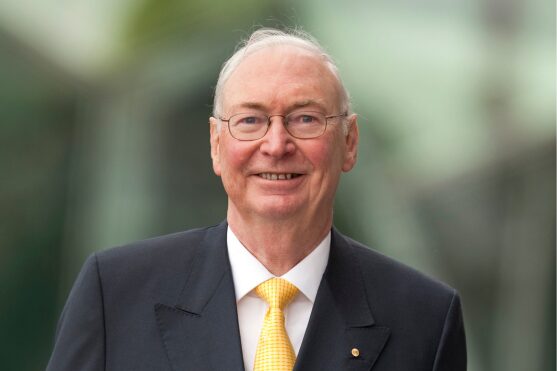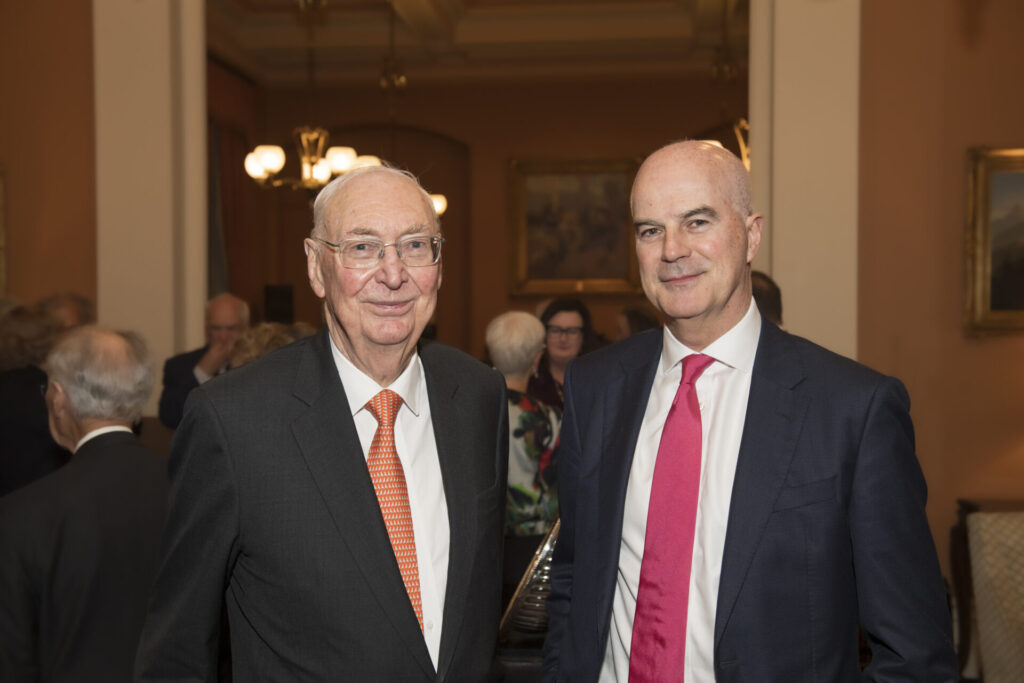Interview with Charles Goode AC, the recently retired Chairman of The Ian Potter Foundation

In late March this year, The Ian Potter Foundation announced the retirement of Mr Charles Goode AC from its Board of Governors, effective April 2024. Charles joined the Board at the request of Sir Ian Potter in 1987 and was appointed Chairman in 1994 after the Founder’s death. In this interview, Philanthropy Weekly asks the former Chairman to reflect on his 37 years of service to the Foundation.
Philanthropy Weekly: Firstly, congratulations on completing your time as Chairman of the Board of Governors of The Ian Potter Foundation. What have been the granting highlights of your Chairmanship?
Charles Goode: There are so many, but it’s hard to choose highlights. The Ian Potter Foundation has four pillars – Fair, Healthy, Sustainable and Vibrant. Fair encompasses the Community Wellbeing and Early Childhood Development programs. Healthy comprises Medical Research and Public Health Research programs; Sustainability is the environment program and Vibrant the Arts program. Since I joined the Board in 1987, we have given roughly 29% to projects and initiatives that fall under Fair, a similar percentage to Healthy (29%) and Vibrant (24%), and the remainder towards Sustainability at 18%.
Across these pillars, the Foundation has also awarded over 50 major grants.
Federation Square and NGV Contemporary come to mind in the arts. More recently, we’ve donated significantly to renovating the State Theatre at Arts Centre Melbourne. Then there’s the Ian Potter Museum at the University of Melbourne and the Arts Precinct at Monash University. So, in the arts, there have been quite a few significant grants to galleries and venues, plus gifts to the Australian Ballet, the Queensland Ballet, and the Melbourne Conservatorium of Music.
If you take health, there was the contribution to the Peter McCallum Cancer Centre relocating to the Victorian Comprehensive Cancer Centre. Then there’s the Howard Florey Medical Research Institute, and there was support for a program of cooperation called the Ian Potter Centre for Genomics and Preventable Medicine with the University of Melbourne, Walter and Eliza Hall Institute and the Victorian Comprehensive Cancer Centre.
If you look at community wellbeing, there have been many small grants with a big emphasis on helping volunteer and community organisations. The grants that come to mind are those to White Box Enterprises, Hello Sunday Morning, Launch Housing, HammondCare, Wintringham, the Education Benalla Program (Tomorrow Today Foundation) and the Clontarf Foundation.
If you take the environment, I think the series of grants supporting the Potter Farmland Project in the 1980s and 1990s are significant. The Foundation has also been a big supporter of ClimateWorks at Monash University and The Wentworth Group of Concerned Scientists. We have given a number of grants to the Royal Botanic Gardens, including the establishment of the Children’s Garden. We were also a major early supporter of developing the Australian Gardens at Royal Botanic Gardens Cranbourne.
PW: You have met an extraordinary number of grantees at your time on the Board of Governors. Do any people or impact stories stand out for you?
CG: The Foundation has given a lot of help to organisations, but it has also been a wonderful experience for me. I have met such wonderful people who serve the community in education, health, and the arts. Many of these people work extraordinarily long hours serving the community for very modest rewards compared to the commercial world. And yet they make such a significant contribution and are such fine people. I admire them, and I enjoy their friendship and values.
PW: That must have been a lovely counterpoint to your business career. Prior to becoming the Chairman of the Board of Governors, you were a Governor. What has changed within the Foundation and its governance since the first meeting you attended?
CG: Until April 2024, there had only been two chairmen of The Ian Potter Foundation. Sir Ian founded the Foundation and was Chairman for 30 years, from 1964 to 1994. I was on the Board for seven years under Sir Ian’s Chairmanship. When he passed away, I became Chairman and remained in that role for 30 years.
At the first meeting I attended, there were six Governors. There was Sir Ian chairing the meeting, plus Sir Roger Darvell, Sir Sydney Sunderland, Professor Tom Healy, Frank Nelson and Professor Graham Ryan. We met three or four times a year. We had one staff member, and we discussed whether proposals would be good to support.
Nowadays, we have 12 or 13 Governors and a staff of 17 people. We meet only four times a year, but we have committees (comprising Governors, the CEO and the appropriate staff members) for each of the four areas I mentioned – Fair, Healthy, Sustainable and Vibrant.
The Foundation might get up to 100 expressions of interest in a particular area, say the Arts, and the program manager will, with the CEO, reduce those applications to 30–40. They’ll then go before the committee and be reduced to, say, five to 10 recommended grants, which will go to the Board for approval.
We initially request expressions of interest so we can respond indicating whether a particular proposal interests us. If so, we ask the applicant to do more detailed work on a full application.
There’s more specialisation and professionalism in the staff to support the management of the Foundation and the organisations we fund. We’ve always been one of the larger foundations and have sought to be very professional and distinguish ourselves by the professionalism of our staff.
Even though the Foundation has changed over the years, it has retained certain principles that are applied when considering applications.
We favour excellence, exceptional talent, or leadership in an area that leads us to give to iconic organisations like the Australian Ballet.
In medicine, we favour projects that are preventative in nature and are very keen on innovation. We are prepared to take a moderate risk on something new to see if it works as a pilot. Then, if successful, it can be broadened into wider community involvement. Governments often need something to be proven and working before they feel they can put their funding behind it. We are happy to be at an earlier stage than the government funding.
We are very keen on projects that involve volunteers and community involvement. We also favour projects that collaborate with other foundations, leveraging our grants. Similarly, we like to see organisations leverage our grants to gain support and funding from the government.
We also consider the long-term implications of proposals. Can the initiatives be sustained, and will they make a difference?
The grants now are also much larger. When I joined the Board of The Ian Potter Foundation, our total donations for 1987 were $1 million. In 1994, when I became Chairman, our total donations were $1.6 million. Last year, we gave $38 million — so that’s how significantly things have grown.
PW: That’s extraordinary.
CG: Over that period, we’ve separated major grants from project grants. Major grants provide a more significant amount of funding over several years. Half of our annual grants go towards major grants, and half go to program grants in those four areas—fair, Healthy, Sustainable, and Vibrant.
We used to assess the impact of our donations when the project was complete. Then, some years ago, when we employed our first Evaluation Manager, we started to assess projects as they were progressing. We would agree on some KPIs with our grantees about what would reflect good performance in spending our funds and achieving their objectives. We monitor these KPIs during the grant, and modifications can be made to progress the project. We believe it has led to a more productive relationship between the organisation and the Foundation.
We’ve also introduced capacity-building grants. We used only to give grants for a particular project. Now, if an organisation is well established, we are happy with its governance, and it’s doing a great job for the community, we will give it a capacity grant to enable it to expand what it’s doing.
We are also finding that smaller organisations can benefit from the non-financial support we can provide, whereby our staff spends time supporting the organisation to which we have given the grant.
PW: How has the philanthropic and not-for-profit sector evolved over your time on the Board of Governors?
CG: The sector has become much larger, more long-term in its thinking and more professional. It’s become an industry that people can join and specialise in various areas, develop a career and have the satisfaction of making an important contribution to our society.
The sector benefits from Philanthropy Australia bringing international visitors to Australia and having seminars where the people in the philanthropic bodies get together.
The Ian Potter Foundation has always given across the community. I think that’s because when we started, there weren’t many foundations. We felt the need and saw the benefit of giving across the spectrum of society, and we have maintained that philosophy.
PW: What are you most proud of in relation to the prominence of The Ian Potter Foundation today?
CG: I am most proud that we have developed a professional staff who give me confidence that we assess the requests—which are more than we can satisfy—in a manner that gives society the best outcome. I think we’re doing that well. We seek to share that experience with the grant recipients and others in the philanthropic world who wish to collaborate with us.
PW: Thank you for your time, Charles.
